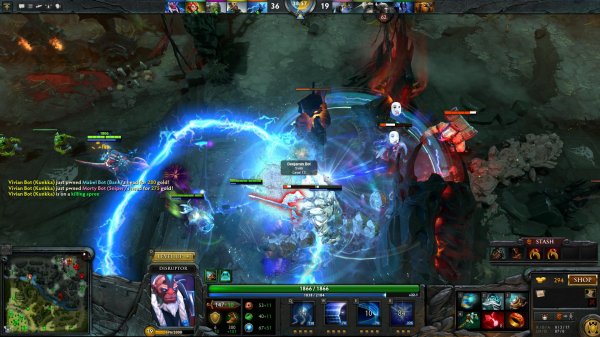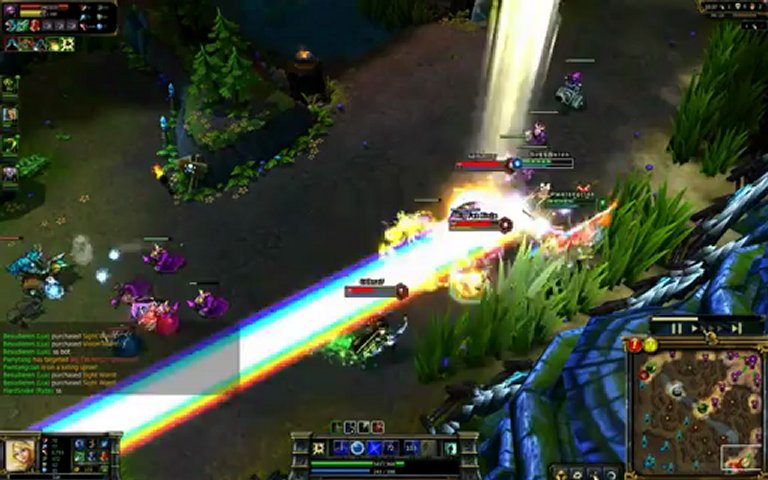LEAGUE OF LEGENDS AND DOTA 2: AN HONEST COMPARISON
A one-on-one comparison of Dota and the League of Legends – especially the gameplay, and what this means for both games.

Okay. Firstly, a disclaimer.
This is a vastly overdone topic. The comparison between these two games – and the fanboy-ism – has been rampant ever since the League came out in ’09. Most comparisons have been heavily biased. Nevertheless, after seeing, playing, reading, discussing and generally poring over these two games, I’m going to compare them. I do not claim to be a veteran Summoner or Dota player: I’m just a guy out to have fun. Part of this comparison is written to help me pick between the two games myself. I’m going to be as fair as I can. The League of Legends Season 3 brought on some changes, which I’m going to integrate into an honest opinion. I don’t differentiate between Dota and Dota 2, because Dota 2 is a very faithful remake of the original.
This is also going to be thorough. i.e: a bit lengthy. Nevermind.
SIMILARITIES
General theme and concept. Riot calls the genre “MOBA”, and the term is catching on – though personally I find “Defense of the Ancients” a much more accurate term. You have champion characters, controlled by players, trying to defend their own base and towers while breaking through the enemies’.
DIFFERENCES
1) The gameplay
On the surface, the gameplay is very similar across all MOBAs. Similar concepts…similar controls, right?
Wrong. On a deeper examination, the differences between DOTA and LOL are huge and have significant impact on gameplay.
DOTA is based around unique heroes with very unique abilities, strengths and weaknesses. It’s entirely about situations. Every hero has a weakness, and often a “counterpick” (another hero) who can exploit that weakness and wreak terrible havoc. Every hero also has a situation where they are absolutely powerful. In Dota there are “right” picks for the situations and “wrong” picks. Every hero has a situation where they will shine and a situation where they will be completely and utterly raped. This leads to a very wide array of heroes, skills, playstyles and gameplay situations. This also leads to the fairly common phenomenon of one good player dominating the opposite team – if the situations are right, one particular hero in his/her element can wipe the floor. Picking the right hero (and knowing how to play it) is a major part of a Dota match.
League of Legends is based around a completely different philosophy: that every hero is as valid as another at any given time. There are no hard-and-fast wrong picks or right picks or counterpicks. Every hero is approximately as valid as the other, assuming you can play them well. Most heroes also can use entirely different builds to gain the advantage. The pwnage phenomenon is much rarer in the League than in Dota. Winning streaks can often be reversed, though not if the enemy is so overfed the difference is too high to catch up. Therefore, the responsibility for wins lies not on a single superpowered hero, but on the entire team as a whole.
This means that, within reasonable limits, you can wade into a battle with any hero and nab a victory.
Dota imposes harsh penalties for failing. Character death is punished with gold loss, widening the gap between hunter and the hunted, eventually leading to large margins between character power levels and fierce competitiveness. The League does not punish actively, which leads to more opportunities to turn the tables on a fed team. Dota punishes more, rewards more, which leads to individual players shining and single-handedly murdering the opposition or bringing disaster down on the whole teem by feeding.
Electric ultimates
This “viability” concept puts the League and Dota on different paths. Most League champions and playstyles share closee similarities and playstyles than their Dota counterparts, and generally seem to fit squarely into certain basic categories – tank, mage, carry, support, jungler. The viability also means that players are more free to pick their favourite hero compared to Dota, where the wide differences between heroes indicate that a team needs a properly balanced lineup to succeed predictably (this is not always the case). The downside is that this leads to certain heroes with similar effects on the battlefield. Eg: Darius and Garen, or Master Yi and Fiora. Then again, you have wild deviations from the norm – like Syndra and Karma.
In Dota the situation is reversed.Characters are too widely varied to be solidly cast into stereotypes. The most common clear-cut distinctions are terms like “early game hero” or “mid to lategame”. Take Razor (the Lightening Revenant) versus the Faceless Void. One shines as an earlygame bruiser, with a very powerful first skill, and after level 9-10 tends to taper off. Endgame, you mostly deal with stopping creeps and pushes and occasionally nuking heroes on low health. The Void grows slowly and moves into usefulness lategame, becoming one of the most dominant champions of the lategame. Earlygame Razor vs Void – if both players are of equal skill levels – is a very predictable outcome. Razor will win.
Lategame, Razor stands no chance.
This is an important distinction, because in the League there is no real “early game hero” or “late game hero”. All heroes, depending on build, can scale approximately as effectively as the other guy. It’s not a hard-and-fast rule, but it’s there. League of Legends is based around heroes filling their spot in this metagame. Players fit squarely into certain roles – tank, support, etc – which they carry out to the best of their ability. This structure is put to good use in Riot in game balancing. Riot uses a metagame concept to balance gameplay at all levels – basically, a meta is a rough roadmap on what each role is expected to do.
Winning, therefore, or getting a kill, boils down mostly to teamwork between heroes in League of Legends. Dota is more freeform in comparison, based around hard counters – individual heroes who can steamroll the opposition – leading to “wilder” games – i.e: godlike wins and humiliating losses.

Conclusion: The League seems to promote balance and thrives on positioning and teamwork, whereas Dota thrives on imbalance and creating situations to tip the balance in your (individual) favor.
2) Items and builds
Items in the two games cannot be directly compared. Of course, there are similar items – almost everything increases either your attack, regen, movement speed etc. One thing I’ve noticed is that more Dota items tend to have active skills. Again, this add to the variety of the game. Certain items also go very well with hero abilities, often amplifying them.
3) Learning curve
There’s a major argument among players that “LoL is easy, Dota is hard”. This invariably devolves into calling League of Legends a noob game.
The learning curve in the League is indeed far less steeper than in Dota. The widely variant emergent gameplay of Dota and the active punishment seems to create a steep barrier to entry. Entry levels for the League are much lower. The absence of active punishment for death, the metagame, the viability of most heroes most of the time, means that League of Legends is easier on the individual level for beginners.
The absence of the deny mechanic in League of Legends means that play is slightly less focused on minions and more on PvP. The presence of denying in Dota makes it so that strong timing skills are neccesary to play competitively. Both games use the last hitting mechanic. The gameplay in Dota is slightly faster-paced, item-and hero-oriented, and considerably harder to pick up. The League is slower, team-oriented, easier to pick up and play.
Complexity is still there. Ganking and jungling in the two games are different. LoL has it’s bushes, which enables gankers to hide in plain sight. Literally. Dota has a complex maze of jungle paths that are ideal for popping up behind your enemy and wiping him out.
At higher levels of skill both games are about as difficult. It’s like baseball and cricket.Both involve hitting a ball with a bat. Cricket players run up and down to score runs. Baseball players use a more complicated system of bases. This doesn’t make it any easier in actual play, because whatever advantages and disadvantages you have, your opponents have them too. It’s not player-vs-game: it’s player-vs-player using the game as a platform. Dota has you denying creeps and tower kills. Your opponent has to do that, too. Take out the deny mechanic and a fight between you won’t be easier – you’ll just have more time to spend hitting each other. In both games you have heroes with murderous ulti’s – like Death Prophet, Faceless Void, Lux and Karthus – but only in Dota are they completely game-changing. As stated before, it’s easier to turn the tables in the League.

Conclusion: The League is faster, easier to pick up – note the word “pick up” – and play. Both games require considerable skill to master due to the different gameplay mechanics. The League is more team-oriented: Dota is more centered on the single hero.
PcGamer did an article (see below). With all due respect, I don’t agree with that question at all. There’s some valid points in there, but neither are better games than each other. They’re both MOBAs on the surface, different on the inside. You can look at paper stats, but both games are just as fun to their players and a random player from Dota, say, dropping into a diehard LoL tournament will get his ass handed to him on a silver platter. And vice versa.
It’s very easy for Dota players to diss LoL for cartoonish graphics and call it “simpified Dota”, or for LoL players to mock Dota 2 for it’s unfriendly interfaces and call it stagnant gameplay. The truth is that both games are too different to be directly thrown at each other – and that players can easily enjoy both games without detracting from the experience of one.
GG.
Read more about:
BlogsAbout the Author(s)
You May Also Like













